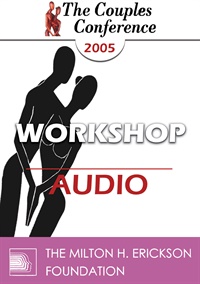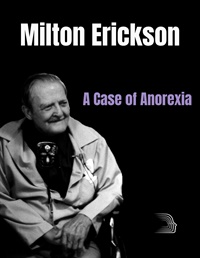
- Average Rating:
- Not yet rated
- Topic Areas:
- Workshops | Couples Therapy | Hypnosis | Hypnotherapy | Experiential Therapy
- Categories:
- Couples Conference | Couples Conference 2005
- Faculty:
- Jeffrey Zeig, PhD
- Duration:
- 2:08:39
- Format:
- Audio Only
- Original Program Date:
- Mar 04, 2005
- Short Description:
- Hypnosis is an experiential method of "gift wrapping" ideas. With or without formal trance, hypnotic methods can be used in the assessment and intervention process of couples therapy.
- Price:
- $15.00 - Base Price

- Average Rating:
- Not yet rated
- Topic Areas:
- Workshops | Couples Therapy | Hypnosis | Sex and Sexuality | Ericksonian Hypnosis and Therapy Techniques
- Categories:
- Couples Conference | Couples Conference 2005
- Faculty:
- Jeffrey Zeig, PhD
- Duration:
- 1:47:54
- Format:
- Audio Only
- Original Program Date:
- Mar 06, 2005
- Short Description:
- Covered in this workshop will be an overview of issues in sex counseling; demographic information; issues in assessment; a phenomenological model; Ericksonian assumptions; and couples exercises for enhancing intimacy.
- Price:
- $15.00 - Base Price

- Average Rating:
- Not yet rated
- Topic Areas:
- Workshops | Couples Therapy | Hypnosis | Sex and Sexuality | Ericksonian Hypnosis and Therapy Techniques
- Categories:
- Couples Conference | Couples Conference 2005
- Faculty:
- Jeffrey Zeig, PhD
- Duration:
- 2:38:21
- Format:
- Audio Only
- Original Program Date:
- Mar 06, 2005
- Short Description:
- Continuing from the morning program, covered in this workshop are principles for using hypnosis; advantages of hypnosis in sex counseling; experiential methods; induction approaches for hypnosis and sex therapy; and Erickson cases.
- Price:
- $15.00 - Base Price

- Average Rating:
- Not yet rated
- Topic Areas:
- Keynotes | Couples Therapy | Trauma | Eye Movement Desensitization and Reprocessing (EMDR) | Hypnosis | Neurobiology
- Categories:
- Couples Conference | Couples Conference 2008
- Faculty:
- Bessel van der Kolk, MD
- Duration:
- 1:05:52
- Format:
- Audio Only
- Original Program Date:
- Apr 25, 2008
- Short Description:
- Starting with a review of recent studies on the neurobiology of trauma, Dr. van der Kolk will examine the utility of approaches from the fields of hypnosis, body oriented therapies and EMDR, both with research data and videotaped clinical interventions. The integration of these approaches during different stages of treatment will be discussed.
- Price:
- $15.00 - Base Price

- Average Rating:
- Not yet rated
- Topic Areas:
- Keynotes | Couples Therapy | Hypnosis | Art and Creativity | Psychology
- Categories:
- Couples Conference | Couples Conference 2009
- Faculty:
- Jeffrey Zeig, PhD
- Duration:
- 1:03:53
- Format:
- Audio Only
- Original Program Date:
- May 02, 2009
- Short Description:
- Clients often request changes in mood and perspective. Traditionally, changing mood and perspective is accomplished by educating clients about their patterns, encouraging them to change their behaviors and thoughts. But, experiential methods can be more immediately effective. All art is, by definition "experiential." And altering mood and perspective is the point of it - whether drama, painting, literature, dance, or music. Movies use multilayered methods for change. The viewer is often unaware of the intricate dramatic, experiential methods that filmmakers use to exert influence.
- Price:
- $15.00 - Base Price
- Average Rating:
- Not yet rated
- Topic Areas:
- Anorexia | Eating Disorders | Milton Erickson | Ericksonian Hypnosis and Therapy Techniques | Utilization | Hypnosis
- Categories:
- Erickson Materials | Erickson Streaming Video Collection | Milton H. Erickson Collections
- Faculty:
- Milton H. Erickson, MD | Jeffrey Zeig, PhD
- Course Levels:
- Master Degree or Higher in Health-Related Field
- Duration:
- 1 hour
- Format:
- Audio and Video
- Original Program Date:
- Apr 27, 2020
- Short Description:
- In this video, you will see Erickson’s unusual way of treating anorexia. Erickson described himself as a person who has an iron fist, but a velvet glove. He knew when it was right to be firm, to be disciplined, and even to be assertive in work with a client. Dr. Jeffrey Zeig provides insightful commentary on this historic Erickson clip.
- Price:
- $29.95 - Base Price
- Average Rating:
- Not yet rated
- Topic Areas:
- Trauma | Ericksonian Hypnosis and Therapy Techniques | Milton Erickson | Storytelling | Hypnosis
- Categories:
- Lounsbury Winston Donation | Erickson Materials | Milton H. Erickson Collections | Erickson Streaming Video Collection
- Faculty:
- Milton H. Erickson, MD | Jeffrey Zeig, PhD
- Course Levels:
- Master Degree or Higher in Health-Related Field
- Duration:
- 1 Hour 13 Minutes
- Format:
- Audio and Video
- Original Program Date:
- Dec 31, 1972
- Short Description:
- For this one-hour video, we reached backed into the Erickson archives, circa 1973 to 1978, to Milton Erickson’s teaching seminars. Erickson conducted these teaching seminars in the comfort and intimacy of his own home. In this video, we encounter three cases – each dealing primarily with trauma. And in each of these cases, there is hidden meaning. Erickson demonstrates how to take “extraneous” information provided by the client, understand the context relevant to the client’s problem, and insightfully extrapolate the true meaning for therapeutic effect.
- Price:
- $19.95 - Base Price
- Average Rating:
- Not yet rated
- Topic Areas:
- Pain and Healing | Milton Erickson | Ericksonian Hypnosis and Therapy Techniques | Hypnosis | Strategic Therapy | Utilization | Cancer
- Categories:
- Erickson Materials | Erickson Streaming Video Collection | Milton H. Erickson Collections
- Faculty:
- Milton H. Erickson, MD | Jeffrey Zeig, PhD
- Course Levels:
- Master Degree or Higher in Health-Related Field
- Duration:
- 1 hour
- Format:
- Audio and Video
- Original Program Date:
- May 07, 2020
- Short Description:
- This video features three separate cases, but all demonstrate Erickson’s fundamental method of utilization. Utilization is the foundation of solutions to all problems, and it is a philosophy of living which was central Erickson’s life and work as a therapist. He demonstrated that whatever existed in the situation, whatever the patient presented, could be utilized to advance the therapy.
- Price:
- $29.95 - Base Price
This program is not available for credit.
- Average Rating:
- Not yet rated
- Topic Areas:
- Sex and Sexuality | Ericksonian Hypnosis and Therapy Techniques | Milton Erickson | Couples Therapy | Children and Adolescent Therapy | Humor | Hypnosis
- Categories:
- Erickson Materials | Erickson Streaming Video Collection | Milton H. Erickson Collections
- Faculty:
- Jeffrey Zeig, PhD | Milton H. Erickson, MD
- Course Levels:
- Master Degree or Higher in Health-Related Field
- Duration:
- 1 hour
- Format:
- Audio and Video
- Original Program Date:
- Jul 07, 2020
- Short Description:
- In this video, Dr. Milton Erickson describes sexual development — from infancy to adulthood, with a focus on male sexual maturation. As Erickson’s describes sexual development, the viewer feels as if they are going through the process as well. Erickson also includes humorous anecdotes of his children as they grew into adults. At the end of the video Dr. Jeffrey Zeig comments on Erickson’s fascinating teaching methods and communication techniques.
- Price:
- $19.95 - Base Price
Credit available - Click Here for more information
- Average Rating:
- Not yet rated
- Topic Areas:
- Milton Erickson | Sex and Sexuality | Ericksonian Hypnosis and Therapy Techniques | Experiential Therapy | Storytelling | Strategic Therapy | Hypnosis
- Categories:
- Erickson Materials | Erickson Streaming Video Collection | Milton H. Erickson Collections | Online Continuing Education
- Faculty:
- Jeffrey Zeig, PhD | Milton H. Erickson, MD
- Course Levels:
- Master Degree or Higher in Health-Related Field
- Duration:
- 1 Hour 8 Minutes
- Format:
- Audio and Video
- Original Program Date:
- Sep 24, 2020
- Short Description:
- In Part 2 of Dr. Erickson’s Orientation to Sexual Development, Milton Erickson continues his interesting lecture about the natural developmental processes involved with sexual/relational maturity. This video begins with Erickson telling charming stories of his sons sexually and relationally developing, which illustrate the principles outlined in the video.
- Price:
- $19.95 - Base Price
Please wait ...






